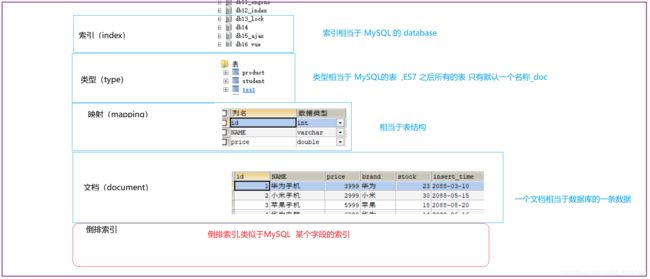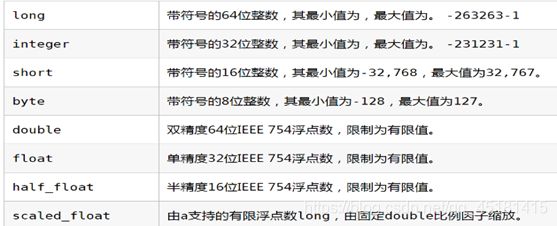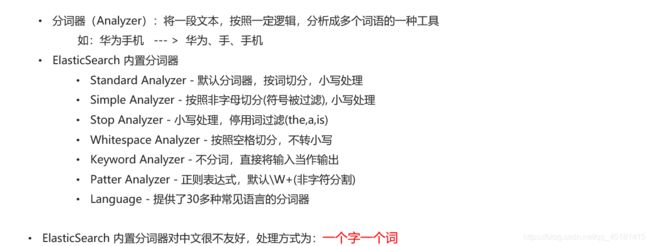Elasticsearch入门
1-Elasticsearch入门
2-初识ElasticSearch
2.1-基于数据库查询的问题
数据库查询存在的问题:
-
性能低:使用模糊查询,左边有通配符,不会走索引,会全表扫描,性能低
-
功能弱:
-
对于如下的数据如果以”华为手机“作为条件,查询不出来数据
select * from goods where title like '%华为手机%' -
华为手机需要拆成华为和手机两个词然后分别查询
select * from goods where title like '%华为%' or title like '%手机%' -
但是MySQL等关系型数据库并没有拆分词语的功能
-
Es通过倒排索引解决这些问题,比如京东的商品信息就保存在ElasticSearch中,可以很快速的得到搜索结果
2.2-倒排索引
正向索引:由《静夜思》–>床前明月光—>“前”字
倒排索引(反向索引):将文档进行分词,形成词条和id的对应关系即为反向索引。
-
先对“床前明月光”–> 分词
将一段文本按照一定的规则,拆分为不同的词条(term)
-
所有的分词结果都记录对应的诗句内容
反向索引的实现就是对诗句进行分词,分成单个的词,由词推句,即为反向索引
2.3-ES存储和查询的原理
需要解决数据库查询存在的问题:
-
性能低:使用模糊查询,左边有通配符,不会走索引,会全表扫描,性能低
-
功能弱:对于如下的数据如果以”华为手机“作为条件,查询不出来数据
存储和查询原理:
-
存储
对存储数据中的title进行分词,记录每个词语和数据id的对应关系(倒排索引)
-
搜索:使用倒排索引,自定将对title进行分词(“华为”,“手机”),找到所有的匹配:1,2,3
使用“华为手机”作为关键字查询
2.4-ES概念详解
Lucene:是一套用于全文检索和搜寻的开源程式库,由Apache软件基金会支持和提供
ElasticSearch是一个基于Lucene的搜索服务器。隐藏了Lucene的复杂性,对外提供Restful 接口来搜索
es和solr选择哪个?
1.如果你公司现在用的solr可以满足需求就不要换了。
2.如果你公司准备进行全文检索功能的开发,建议优先考虑es,因为像Github这样大规模的搜索都在用它。
介绍
-
一个分布式、高扩展、高实时的搜索与数据分析引擎
-
基于RESTful web接口:http请求进行增删查改
-
用Java语言开发的,并作为Apache许可条款下的开放源码发布,是一种流行的企业级搜索引擎
应用场景
-
搜索:海量数据的查询
1)用户在前端搜索关键字
2)项目前端通过http方式请求项目服务端
3)项目服务端通过Http RESTful方式请求ES集群进行搜索
4)ES集群从索引库检索数据 -
日志数据分析
-
实时数据分析
2.5 ES和MySQL的区别
•MySQL有事务性,而ElasticSearch没有事务性,所以你删了的数据是无法恢复的。
•ElasticSearch没有物理外键这个特性,,如果你的数据强一致性要求比较高,还是建议慎用
•ElasticSearch和MySql分工不同,MySQL负责存储(增删改)数据,ElasticSearch负责搜索数据。
MySQL同步数据到ES常用工具:
- 通过JavaAPI写入ES
- logstash, es官方推荐的
- canal, 阿里开源的
3-启动ElasticSearch
3.1-ES启动
查看elastic是否启动
ps -ef|grep elastic
启动ES
#switch user
su ithe # 切换到ithe用户启动
#password=ithe
cd /opt/elasticsearch-7.4.0/bin
./elasticsearch #启动
访问地址:192.168.52.128:9200
3.2-ES辅助工具启动
克隆远程连接会话,启动Kibana:
# 切换到kibana的bin目录
cd /opt/kibana-7.4.0-linux-x86_64/bin
# 启动
./kibana --allow-root
浏览器访问:http://192.168.52.128:5601/
4-核心概念(重点)
1 索引(index)
ElasticSearch存储数据的地方,可以理解成关系型数据库中的数据库概念。
2 类型(type)
一种type就像一类表。如用户表、角色表等。在Elasticsearch7.X默认type为_doc
\- ES 5.x中一个index可以有多种type。
\- ES 6.x中一个index只能有一种type。
\- ES 7.x以后,将逐步移除type这个概念,现在的操作已经不再使用,默认_doc
3 映射(mapping)
mapping定义了每个字段的类型、字段所使用的分词器等。相当于关系型数据库中的表结构。
4 文档(document)
Elasticsearch中的最小数据单元,常以json格式显示。一个document相当于MySQL数据库中的一行数据。
5 倒排索引
一个倒排索引由文档中所有不重复词的列表构成,对于其中每个词,对应一个包含它的文档id列表。
对比MySQL
5-脚本操作ES(重点)
5.1-复习RESTful风格
1.REST(Representational State Transfer),表述性状态转移,是一组架构约束条件和原则。满足这些约束条件和原则的应用程序或设计就是RESTful。就是一种定义接口的规范。
2.基于HTTP。
3.使用XML格式定义或JSON格式定义。
4.每一个URI代表一种资源。
5.客户端使用GET、POST、PUT、DELETE 4个表示操作方式的动词对服务端资源进行操作:
GET:用来获取资源(查询)
POST:用来新建资源(新增)
PUT:用来更新资源(修改)
DELETE:用来删除资源(删除)
5.2-操作索引
使用Kibana操作ES:http://192.168.52.128:5601/
kibana是操作ES的WEB客户端,相当于操作MySQL数据库的sqlyog
# 创建索引
PUT person
# 查看索引
GET person
# 删除索引(同时会删除其所有数据,相当于mysql的drop database)
DELETE person
# 查询所有索引
GET _all
delete /c* (通配符删除c 开头的索引)
5.3-ES数据类型
- 简单数据类型
-
字符串
text:会分词,不支持聚合 keyword:不会分词,将全部内容作为一个词条,支持聚合 -
数值:long.inteter,double等
-
布尔:boolean
-
二进制:binary
-
范围类型
integer_range, float_range, long_range, double_range, date_range -
日期:date
- 复杂数据类型
-
数组:[ ] Nested:
nested(for arrays of JSON objects 数组类型的JSON对象) -
对象:{ } Object: object(for single JSON objects 单个JSON对象)
注意: 字段类型没有修改功能
5.4-操作映射
5.4.1 添加
# 删除索引(同时会删除其所有数据,相当于mysql的drop database)
DELETE person
# 创建索引
PUT person
# 查看索引
GET person
# 添加映射(相当于添加表字段)
PUT /person/_mapping
{
"properties":{
"name":{
"type":"text"
},
"age":{
"type":"integer"
}
}
}
5.4.2 查看
# 仅查看映射(查看表结构)
GET person/_mapping
# 仅查看索引,会自动显示表结构(查看表结构)
GET person
5.4.3 索引+ 映射一起创建
# 创建索引并添加映射(相当于建立数据库时,(因为只有一张表type=_doc)同时制定表字段)
PUT /person
{
"mappings": {
"properties": {
"name": {
"type": "text"
},
"age": {
"type": "integer"
}
}
}
}
5.5-操作文档
5.5.1添加/更新文档
# 指定id,如果id=1数据不存在,则添加(insert)数据;否则是修改(update)
PUT /person/_doc/1
{
"name":"张三",
"age":18,
"address":"北京海淀区"
}
# 添加文档,不指定id
POST /person/_doc/
{
"name":"王五",
"age":18,
"address":"北京"
}
5.5.2查看文档(简单查看)
# 根据id 查看
GET /person1/_doc/1
# 查看所有(无条件查询)
GET /person1/_search
5.5.3删除
# 删除指定id文档
DELETE /person1/_doc/1
6-分词器
6.1分词器-介绍
6.2-ik分词器
中文分词器
•IKAnalyzer是一个开源的,基于java语言开发的轻量级的中文分词工具包
•是一个基于Maven构建的项目
•具有60万字/秒的高速处理能力
•支持用户词典扩展定义
•下载地址:https://github.com/medcl/elasticsearch-analysis-ik/archive/v7.4.0.zip
6.3-ik分词器使用
IK分词器有两种分词模式:ik_max_word和ik_smart模式
1、ik_max_word
# 方式一ik_max_word
# 会将文本做最细粒度的拆分,比如会将“乒乓球明年总冠军”拆分为“乒乓球、乒乓、球、明年、总冠军、冠军。
GET /_analyze
{
"analyzer": "ik_max_word",
"text": "乒乓球明年总冠军"
}
ik_max_word分词器执行如下:
{
"tokens" : [
{
"token" : "乒乓球",
"start_offset" : 0,
"end_offset" : 3,
"type" : "CN_WORD",
"position" : 0
},
{
"token" : "乒乓",
"start_offset" : 0,
"end_offset" : 2,
"type" : "CN_WORD",
"position" : 1
},
{
"token" : "球",
"start_offset" : 2,
"end_offset" : 3,
"type" : "CN_CHAR",
"position" : 2
},
{
"token" : "明年",
"start_offset" : 3,
"end_offset" : 5,
"type" : "CN_WORD",
"position" : 3
},
{
"token" : "总冠军",
"start_offset" : 5,
"end_offset" : 8,
"type" : "CN_WORD",
"position" : 4
},
{
"token" : "冠军",
"start_offset" : 6,
"end_offset" : 8,
"type" : "CN_WORD",
"position" : 5
}
]
}
2、ik_smart
# 方式二ik_smart
# 会做最粗粒度的拆分,比如会将“乒乓球明年总冠军”拆分为乒乓球、明年、总冠军。
GET /_analyze
{
"analyzer": "ik_smart",
"text": "乒乓球明年总冠军"
}
ik_smart分词器执行如下:
{
"tokens" : [
{
"token" : "乒乓球",
"start_offset" : 0,
"end_offset" : 3,
"type" : "CN_WORD",
"position" : 0
},
{
"token" : "明年",
"start_offset" : 3,
"end_offset" : 5,
"type" : "CN_WORD",
"position" : 1
},
{
"token" : "总冠军",
"start_offset" : 5,
"end_offset" : 8,
"type" : "CN_WORD",
"position" : 2
}
]
}
由此可见:使用ik_smart可以将文本"text": "乒乓球明年总冠军"分成了【乒乓球】【明年】【总冠军】
这样看的话,这样的分词效果更智能一些,达到了我们的要求。
6.4使用IK分词器-查询文档
6.4.1 准备测试数据
1.创建索引,添加映射,并指定分词器为ik分词器
# 如果有删除
DELETE person
# 添加映射_指定分词器(相当于添加表字段)
PUT person
{
"mappings": {
"properties": {
"name": {
"type": "keyword" // keyword 类型 不会分词
},
"address": {
"type": "text", // text 类型 会分词, 但不能进行聚合查询(类似SQL group by/sum函数)
"analyzer": "ik_max_word"
}
}
}
}
GET person
2.添加文档
# 添加几条数据备用
# 指定id
POST /person/_doc/1
{
"name":"张三",
"age":18,
"address":"北京海淀区"
}
POST /person/_doc/2
{
"name":"李四",
"age":18,
"address":"北京朝阳区"
}
POST /person/_doc/3
{
"name":"王五",
"age":18,
"address":"北京昌平区"
}
POST /person/_doc/4
{
"name":"李雷",
"age":18,
"address":"华为5G手机"
}
3.查询映射数据
GET /person/_search
4.查看分词效果
GET _analyze
{
"analyzer": "ik_max_word",
"text": "北京昌平"
}
6.4.2 term查询-关键词
词条查询:term,不会将查询条件拆分
GET /person/_search
{
"query": {
"term": {
"address": {
"value": "北京昌平"
}
}
}
}
6.4.3 match查询-全文
全文查询:match
全文查询会分析查询条件,先将查询条件进行分词,然后查询,求并集
GET /person/_search
{
"query": {
"match": {
"address": "北京昌平"
}
}
}
# 1.对查询条件“北京昌平”进行分词: 北京,昌平
# 2.根据分词结果逐个查询
-
词条查询:term
词条查询不会分析查询条件,只有当词条和查询字符串完全匹配时才匹配搜索
-
全文查询:match
全文查询会分析查询条件,先将查询条件进行分词,然后查询,求并集(or)
7-JavaAPI(重点)
7.1-SpringBoot整合ES
①搭建SpringBoot工程
②引入ElasticSearch相关坐标
<parent>
<groupId>org.springframework.bootgroupId>
<artifactId>spring-boot-starter-parentartifactId>
<version>2.1.8.RELEASEversion>
<relativePath/>
parent>
<dependencies>
<dependency>
<groupId>org.springframework.bootgroupId>
<artifactId>spring-boot-starterartifactId>
dependency>
<dependency>
<groupId>org.springframework.bootgroupId>
<artifactId>spring-boot-starter-testartifactId>
<scope>testscope>
dependency>
<dependency>
<groupId>org.elasticsearch.clientgroupId>
<artifactId>elasticsearch-rest-high-level-clientartifactId>
<version>7.4.0version>
dependency>
<dependency>
<groupId>org.elasticsearch.clientgroupId>
<artifactId>elasticsearch-rest-clientartifactId>
<version>7.4.0version>
dependency>
<dependency>
<groupId>org.elasticsearchgroupId>
<artifactId>elasticsearchartifactId>
<version>7.4.0version>
dependency>
<dependency>
<groupId>org.projectlombokgroupId>
<artifactId>lombokartifactId>
dependency>
<dependency>
<groupId>com.alibabagroupId>
<artifactId>fastjsonartifactId>
<version>1.2.4version>
dependency>
dependencies>
③测试
-
编写配置类ElasticSearchConfig
@Configuration @ConfigurationProperties(prefix="elasticsearch") public class ElasticSearchConfig { private String host; private int port; //添加get,set方法 @Bean public RestHighLevelClient client(){ return new RestHighLevelClient(RestClient.builder( new HttpHost(host,port,"http") )); } } -
配置es信息: resources\application.yml
elasticsearch: host: 192.168.52.128 port: 9200 -
编写单元测试类:ElasticsearchDay01ApplicationTests
注意:使用@Autowired注入RestHighLevelClient 如果报红线,则是因为配置类所在的包和测试类所在的包,包名不一致造成的
@RunWith(SpringRunner.class) @SpringBootTest(classes = ElasticsearchDemoApplication.class) public class ElasticsearchDemoApplicationTests { @Autowired private RestHighLevelClient client; @Test public void contextLoads() { System.out.println(client); } }
7.2-创建索引
1.添加索引
注意导包:org.elasticsearch.client.indices.CreateIndexRequest
/**
* 添加索引
*/
@Test
public void addIndex() throws IOException {
//1.使用client获取操作索引的对象
IndicesClient indicesClient = client.indices();
//2.具体操作,获取返回值
CreateIndexRequest createRequest = new CreateIndexRequest("ithe");
CreateIndexResponse response = indicesClient.create(createRequest,
RequestOptions.DEFAULT);
//3.根据返回值判断结果
System.out.println(response.isAcknowledged());
}
2.添加索引,并添加映射
/**
* 添加索引,并添加映射
*/
@Test
public void addIndexAndMapping() throws IOException {
//1.使用client获取操作索引对象
IndicesClient indices = client.indices();
//2.具体操作获取返回值
//2.具体操作,获取返回值
CreateIndexRequest createIndexRequest = new CreateIndexRequest("test");
//2.1 设置mappings
String mapping = "{\n" +
" \"properties\" : {\n" +
" \"address\" : {\n" +
" \"type\" : \"text\",\n" +
" \"analyzer\" : \"ik_max_word\"\n" +
" },\n" +
" \"age\" : {\n" +
" \"type\" : \"long\"\n" +
" },\n" +
" \"name\" : {\n" +
" \"type\" : \"keyword\"\n" +
" }\n" +
" }\n" +
" }";
createIndexRequest.mapping(mapping,XContentType.JSON);
CreateIndexResponse createIndexResponse = indices.create(createIndexRequest, RequestOptions.DEFAULT);
//3.根据返回值判断结果
System.out.println(createIndexResponse.isAcknowledged());
}
7.3-查询、删除、判断索引
- 查询索引
/**
* 查询索引
*/
@Test
public void queryIndex() throws IOException {
IndicesClient indices = client.indices();
GetIndexRequest getRequest=new GetIndexRequest("test");
GetIndexResponse response = indices.get(getRequest, RequestOptions.DEFAULT);
Map<String, MappingMetaData> mappings = response.getMappings();
//iter 提示foreach
for (String key : mappings.keySet()) {
System.out.println(key+"==="+mappings.get(key).getSourceAsMap());
}
}
- 删除索引
/**
* 删除索引
*/
@Test
public void deleteIndex() throws IOException {
IndicesClient indices = client.indices();
DeleteIndexRequest deleteRequest=new DeleteIndexRequest("ithe");
AcknowledgedResponse delete = indices.delete(deleteRequest, RequestOptions.DEFAULT);
System.out.println(delete.isAcknowledged());
}
- 索引是否存在
/**
* 索引是否存在
*/
@Test
public void existIndex() throws IOException {
IndicesClient indices = client.indices();
GetIndexRequest getIndexRequest=new GetIndexRequest("ithe");
boolean exists = indices.exists(getIndexRequest, RequestOptions.DEFAULT);
System.out.println(exists);
}
7.4-添加文档
1.添加文档,使用map作为数据
/**
* 添加文档,使用map作为数据
*/
@Test
public void addDoc() throws IOException {
//数据对象,map
Map data = new HashMap();
data.put("address", "北京昌平");
data.put("name", "大胖");
data.put("age", 20);
//1.获取操作文档的对象
IndexRequest request = new IndexRequest("test").id("1").source(data);
//添加数据,获取结果
IndexResponse response = client.index(request, RequestOptions.DEFAULT);
//打印响应结果
System.out.println(response.getId());
}
2.添加文档,使用对象作为数据
<dependency>
<groupId>com.alibabagroupId>
<artifactId>fastjsonartifactId>
<version>1.2.4version>
dependency>
//将对象转为json
String data = JSON.toJSONString(p);
/**
* 添加文档,使用对象作为数据
*/
@Test
public void addDoc2() throws IOException {
//数据对象,javaObject
Person p = new Person();
p.setId("2");
p.setName("小胖2222");
p.setAge(30);
p.setAddress("陕西西安");
//将对象转为json
String data = JSON.toJSONString(p);
//1.获取操作文档的对象
IndexRequest request = new IndexRequest("test").id(p.getId()).source(data,
XContentType.JSON);
//添加数据,获取结果
IndexResponse response = client.index(request, RequestOptions.DEFAULT);
//打印响应结果
System.out.println(response.getId());
}
7.5-修改、查询、删除文档
1.修改文档:添加文档时,如果id存在则修改,id不存在则添加
/**
* 修改文档:添加文档时,如果id存在则修改,id不存在则添加
*/
@Test
public void UpdateDoc() throws IOException {
Person person=new Person();
person.setId("2");
person.setName("李四");
person.setAge(20);
person.setAddress("北京三环车王");
String data = JSON.toJSONString(person);
IndexRequest request=new IndexRequest("test").id(person.getId()).source(data,XContentType.JSON);
IndexResponse response = client.index(request, RequestOptions.DEFAULT);
System.out.println(response.getId());
}
]
2.根据id查询文档
/**
* 根据id查询文档
*/
@Test
public void getDoc() throws IOException {
//设置查询的索引、文档
GetRequest indexRequest=new GetRequest("test","2");
GetResponse response = client.get(indexRequest, RequestOptions.DEFAULT);
System.out.println(response.getSourceAsString());
}
3.根据id删除文档
/**
* 根据id删除文档
*/
@Test
public void delDoc() throws IOException {
//设置要删除的索引、文档
DeleteRequest deleteRequest=new DeleteRequest("test","1");
DeleteResponse response = client.delete(deleteRequest, RequestOptions.DEFAULT);
System.out.println(response.getId());
}
-
新增或修改:
IndexRequest request = new IndexRequest("index_name").id("") client.index() -
查询
GetRequest request = new GetRequest("index_name").id("") client.get() -
删除
DeleteRequest request = new DeleteRequest("index_name").id("") client.delete()


